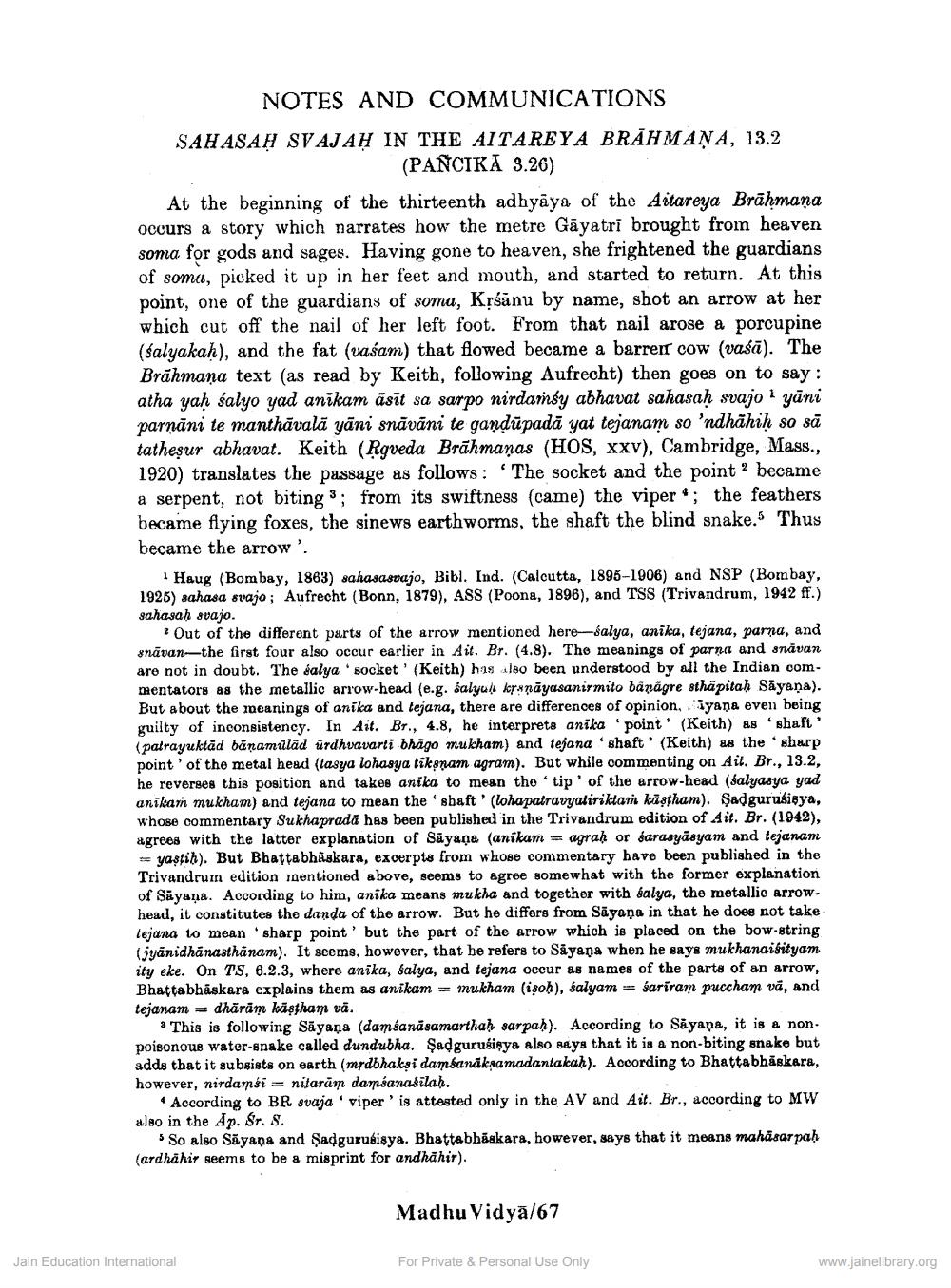________________
NOTES AND COMMUNICATIONS
SAHASAH SVAJAH IN THE AITAREYA BRAHMANA, 13.2 (PANCIKĀ 3.26)
At the beginning of the thirteenth adhyaya of the Aitareya Brahmana occurs a story which narrates how the metre Gayatri brought from heaven soma for gods and sages. Having gone to heaven, she frightened the guardians of soma, picked it up in her feet and mouth, and started to return. At this point, one of the guardians of soma, Kršanu by name, shot an arrow at her which cut off the nail of her left foot. From that nail arose a porcupine (salyakah), and the fat (vasam) that flowed became a barrer cow (vasa). The Brahmana text (as read by Keith, following Aufrecht) then goes on to say: atha yaḥ salyo yad anikam ásit sa sarpo nirdaméy abhavat sahasaḥ svajo1 yāni parṇāni te manthävalä yäni snäväni te gaṇḍüpada yat tejanam so 'ndhāhiḥ so sā tatheṣur abhavat. Keith (Rgveda Brahmanas (HOS, xxv), Cambridge, Mass., 1920) translates the passage as follows: The socket and the point became a serpent, not biting 3; from its swiftness (came) the viper; the feathers became flying foxes, the sinews earthworms, the shaft the blind snake. Thus became the arrow'.
1
Haug (Bombay, 1863) sahasasvajo, Bibl. Ind. (Calcutta, 1895-1906) and NSP (Bombay, 1925) sahasa svajo; Aufrecht (Bonn, 1879), ASS (Poona, 1896), and TSS (Trivandrum, 1942 ff.) sahasaḥ svajo.
Out of the different parts of the arrow mentioned here--salya, anika, tejana, parna, and snavan the first four also occur earlier in Ait. Br. (4.8). The meanings of parna and snävan are not in doubt. The salya socket' (Keith) has also been understood by all the Indian commentators as the metallic arrow-head (e.g. salyah krṣṇāyasanirmito bänägre sthāpitaḥ Sayana). But about the meanings of anika and tejana, there are differences of opinion, ayana even being guilty of inconsistency. In Ait. Br., 4.8, he interprets anika point (Keith) as 'shaft' (patrayuktäd bäṇamülad urdhvavarti bhago mukham) and tejana shaft (Keith) as the sharp point of the metal head (tasya lohasya tikṣṇam agram). But while commenting on Ait. Br., 13.2, he reverses this position and takes anika to mean the tip of the arrow-head (salyasya yad anikam mukham) and tejana to mean the shaft (lohapatravyatiriktam kastham). Sadgurusisya, whose commentary Sukhaprada has been published in the Trivandrum edition of Ait. Br. (1942), agrees with the latter explanation of Sayana (anikam agraḥ or barasyasyam and tejanam yastih). But Bhattabhaskara, excerpts from whose commentary have been published in the Trivandrum edition mentioned above, seems to agree somewhat with the former explanation of Sayana. According to him, anika means mukha and together with salya, the metallic arrowhead, it constitutes the danda of the arrow. But he differs from Sayana in that he does not take tejana to mean sharp point' but the part of the arrow which is placed on the bow-string (jyänidhānasthanam). It seems, however, that he refers to Sayana when he says mukhanaisityam ity eke. On TS, 6.2.3, where anika, salya, and tejana occur as names of the parts of an arrow, Bhattabhaskara explains them as anikam mukham (isoh), salyam sariram puccham vä, and
dhārām kāṣtham vā.
4
tejanam
This is following Sayana (damsanasamarthaḥ sarpaḥ). According to Sayana, it is a non. poisonous water-snake called dundubha. Sadgurusisya also says that it is a non-biting snake but adds that it subsists on earth (mrdbhakṣi dambanakṣamadantakah). According to Bhattabhaskara, however, nirdamsi nitarăm damsanasilah.
=
Jain Education International
According to BR svaja viper' is attested only in the AV and Ait. Br., according to MW also in the Ap. Sr. S.
5 So also Sayana and Sadgurusisya. Bhattabhaskara, however, says that it means mahasarpaḥ (ardhahir seems to be a misprint for andhahir).
Madhu Vidya/67
•
4
For Private & Personal Use Only
www.jainelibrary.org




